- Joined
- Feb 2, 2011
- Messages
- 2,179
THE EIGHTEENTH CENTURY COLLECTION
THE AMERICAN WAR OF INDEPENDENCE
THE BATTLE OF BUNKER HILL, 17th JUNE 1775.
THE ASSAULT ON THE REDOUBT AT BREED’S HILL
Boston was the third largest town in North America, and stood on a Peninsula connected to the mainland by a neck just wide enough to cross at high tide. The harbour, large enough to be strategically significant, and central to the town’s economy, was formed by a chain of islands stretching out to sea, guarded by reefs and ledges.
North west of Boston was Charlestown, a largely rural peninsula one and a half miles long. Charlestown stood at the south east corner with three hills behind it. Bunker’s Hill, nearest the neck of the Peninsula, Breed’s Hill 200 yards above the town and Moulton’s Hill to the north east.
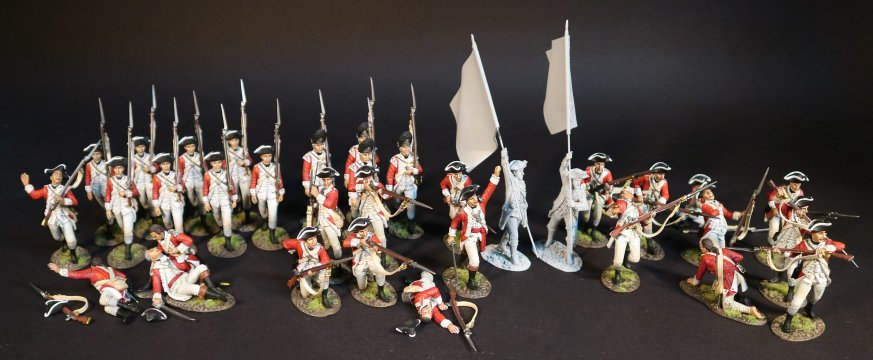
On the 16th June 1775, 3 detachments from Massachusetts regiments under the command of Colonel William Prescott and engineer Captain Richard Gridley, crossed the Charlestown neck and arrived at Bunker Hill.
Captain Richard Gridley and Prescott disagreed as to where they should locate their defense. Some work was performed on Bunker Hill, but Breed’s Hill was closer to Boston and viewed as being more defensible, and they decided to build their primary redoubt there.
Prescott and his men began digging a square fortification about 130 ft a side with ditches and earthen walls. The walls of the redoubt were about 6 feet high.
Work began at midnight, and around 4am one of the British warships spotted the earthworks on Breed’s Hill and opened fire.
The British command agreed that the works posed a significant threat, but were at this time sufficiently incomplete and isolated to offer a chance of a successful attack.
The original British plan was to bypass the redoubt to the north and capture Bunker’s Hill and the neck of the peninsula, thus isolating the redoubt on Breed’s Hill.
The Americans repulsed two British assaults, with significant British casualties. The British captured the redoubt on their third assault, after the defenders had run out of ammunition. The colonists retreated over Bunker Hill, leaving the British finally in control of the Peninsula.
The battle was a tactical victory for the British, but it proved to be a sobering experience for them; they incurred many more casualties than the Americans had sustained, including many officers. The battle had demonstrated that inexperienced militia were able to stand up to regular army troops in battle. Subsequently, the battle discouraged the British from any further frontal attacks against well defended front lines. American casualties were much fewer, although their losses included General Joseph Warren, and Major Andrew McClary, the final casualty of the battle.
BRITISH MARINES
The Marines, which only became “Royal Marines” in 1802, were the Royal Navy’s private army, administered by the Admiralty and controlled by senior naval officers. The rank and file were volunteers and wore army style uniforms and equipment. However they were trained to serve on warships and undertake amphibious operations. The 50 companies, shared between Chatham, Portsmouth and Plymouth, were not regimented, and detachments, or in some cases individual replacements were assigned on an ad hoc basis.
The first Marines sent to Boston were to form a battalion of 600 men under Major Pitcairn, but by March only 336 were present, as they soon became an object of inter service rivalry over pay, food and conditions. Although initially physically inferior to their army comrades, and short of essential equipment for service on land, incessant drilling and regular marches into the countryside soon created a fine unit.
Another group of over 700 men arrived in May, and the whole force formed two battalions, with grenadier and light companies.
The 1st and 2nd Marines were to play an important part in the assault on the southern defences of the Breed’s Hill redoubt.
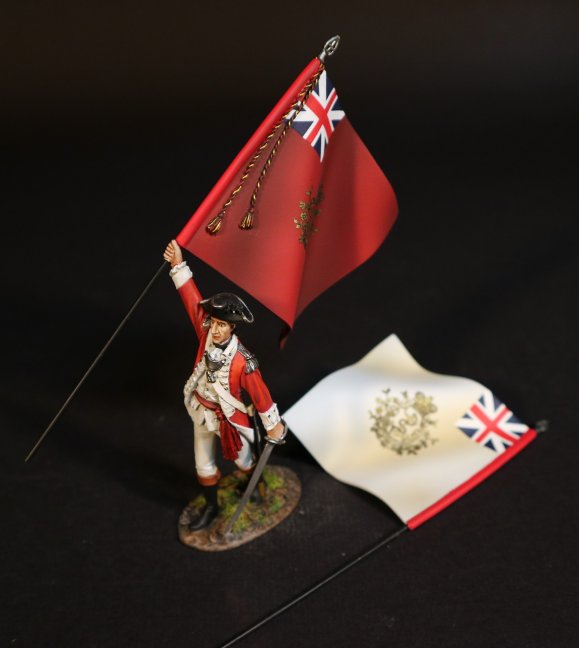
MBHL-03
THE AMERICAN WAR OF INDEPENDENCE 1775-1783,
THE BATTLE OF BUNKER HILL, JUNE 17th 1775,
THE ASSAULT ON THE REDOUBT AT BREED’S HILL,
BRITISH MARINES,
STANDARD BEARER WITH CHOICE OF TWO FLAGS
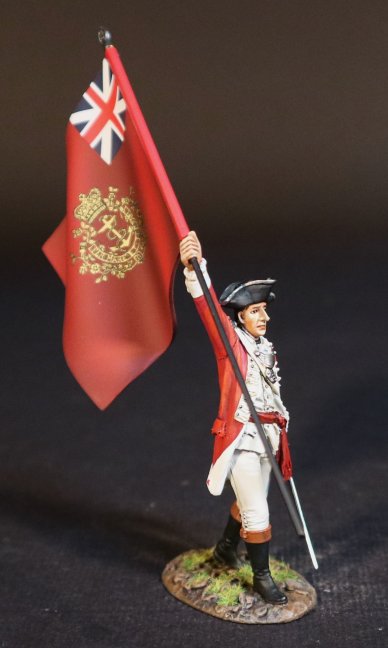
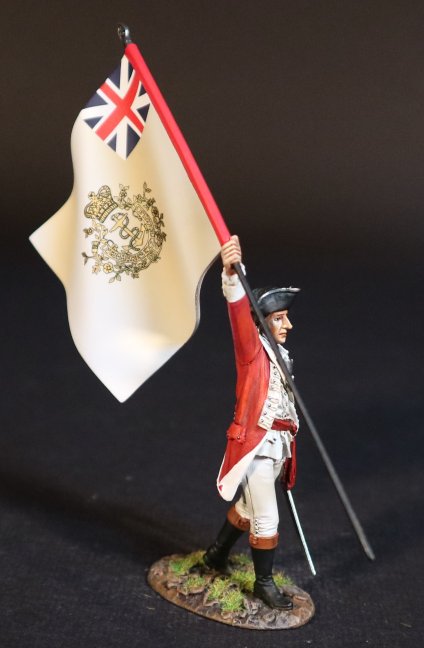
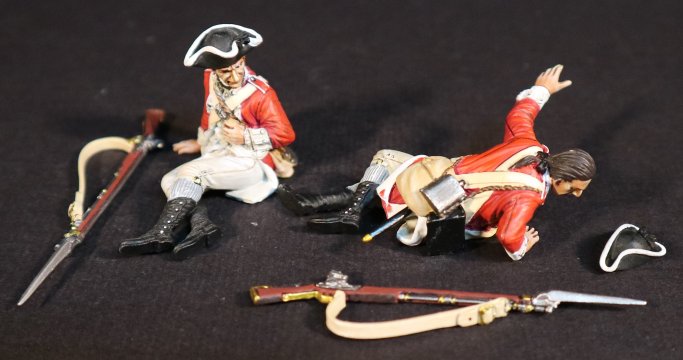
MBHL-17
THE AMERICAN WAR OF INDEPENDENCE 1775-1783,
THE BATTLE OF BUNKER HILL, JUNE 17th 1775,
THE ASSAULT ON THE REDOUBT AT BREED’S HILL,
BRITISH MARINES,
2 BRITISH MARINE CASUALTIES
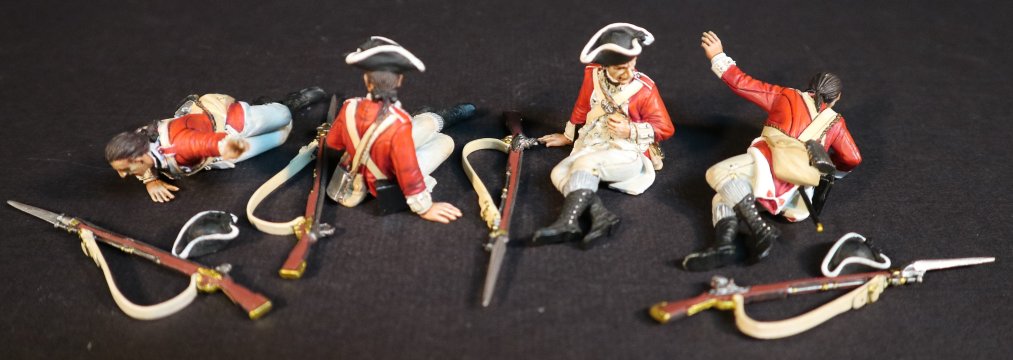
MBHL-17D
THE AMERICAN WAR OF INDEPENDENCE 1775-1783,
THE BATTLE OF BUNKER HILL, JUNE 17th 1775,
THE ASSAULT ON THE REDOUBT AT BREED’S HILL,
BRITISH MARINES,
4 BRITISH MARINE CASUALTIES
THE BATTLE OF COWPENS, JANUARY 17th, 1781.
THE 7th REGIMENT OF FOOT (ROYAL FUSILIERS.)
The Battle of Cowpens was an engagement during the American Revolutionary War fought on January 17th 1781, near the town of Cowpens, South Carolina, between American forces under Brigadier General Daniel Morgan, and British forces under Lieutenant Colonel Banastre Tarleton, as part of the campaign in the Carolinas.
The battle was a turning point in the American reconquest of South Carolina from the British.
Tarleton’s force of 1,000 British troops were set against 2,000 troops under Morgan. Morgan’s forces suffered casualties of only 25 killed and 124 wounded. Tarleton’s force was almost completely eliminated with almost 30% casualties and 55% of his force captured or missing, with Tarleton himself and only about 200 British troops escaping.
Morgan’s forces conducted a double envelopment of the British forces, the only double envelopment of the war.
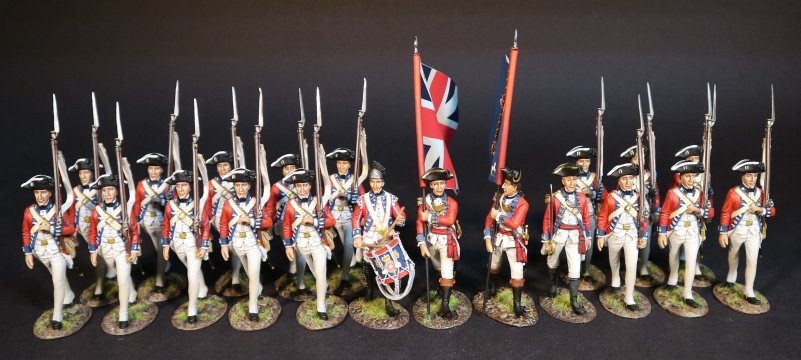
The Royal Fusiliers (city of London Regiment) was a line infantry regiment of the British Army which has been in continuous existence for 283 years. It was known as the 7th Regiment of Foot until the Childers Reforms in 1881.
In 1747 the regiment was known as the Royal English Fuziliers and was given the precedence of 7th in the Infantry of the Line. On 1st July 1751 it was redesignated as the 7th Regiment of Foot (Royal Fusiliers).
When county titles were added in August 1782 the subtitle (Derbyshire) was added, but this was never used and was later given to a different regiment.
The Royal Fusiliers were sent to Canada in April 1773. The regiment was broken up into detachments that served at Montreal, Quebec, Fort Chambly and Fort St. Johns. In the face of the American invasion of Canada in 1775/76, the 80 man garrison of Fort Chambly attempted to resist a 400 man Rebel force but ultimately had to surrender, losing its regimental colours as a result. The bulk of the regiment was captured when St. John’s fell.
A 70 man detachment under the command of Captain Humphrey Owens assisted with the Battle of Quebec in December 1775.
The men taken prisoner during the defence of Canada were exchanged in British held New York city in December 1776. Here the regiment was rebuilt and garrisoned New York and New Jersey. In October 1777, the 7th participated in the successful assaults on Fort Clinton and Fort Montgomery and the destruction of enemy stores at Continental Village. In late November, 1777 the regiment reinforced the garrison of Philadelphia. During the British evacuation back to New York city, the regiment participated in a diversionary raid in the days leading up to the Battle of Monmouth in June 1778.
In April 1780, the Royal Fusiliers took part in the capture of Charleston. Once Charleston fell, the regiment helped garrison the city. Three companies were sent to Ninety-Six to assist with the training of Loyalist militia companies. An 80 man detachment was also sent to Camden, South Carolina to help build that town’s defences. The detachments were recalled to Charleston for refitting in late August 1780.
The 7th, mounted on horses, along with the two regiments of Loyalist militia, cleared the region north of Georgetown, South Carolina of partisans while en route. The Royal Fusiliers turned the horses over to Lieutenant Colonel Banastre Tarleton’s British Legion upon uniting with Cornwallis in late September and then served as the Army’s rearguard.
Between October 1780 and early 1781, the regiment, having lost about one third of its officers and men to sickness and disease, protected the communication and supply lines between Camden and Winnsboro, South Carolina. On 7th January, 1781, a contingent of 171 men from the Royal Fusiliers was detached from Cornwallis’s Army and fought under the command of Tarleton at the Battle of Cowpens in January 1781.
The Royal Fusiliers were on the left of the line of battle: Tarleton was defeated and the regiment’s colours were once again captured, and stored in the baggage wagons.
A 19 man detachment from the regiment fought through North Carolina participating in the Battle of Guilford Court House in March 1781 and ultimately the siege of Yorktown, where it served with the regiment’s Light Infantry Company. There was another detachment, composed largely of men recovered from the hospitals and recruits, which remained in the South under the command of Lt. Col. Alured Clarke. These men remained in garrison in Charleston, until they were transferred to Savannah, Georgia in December 1781.
The regiment returned to England in 1783.
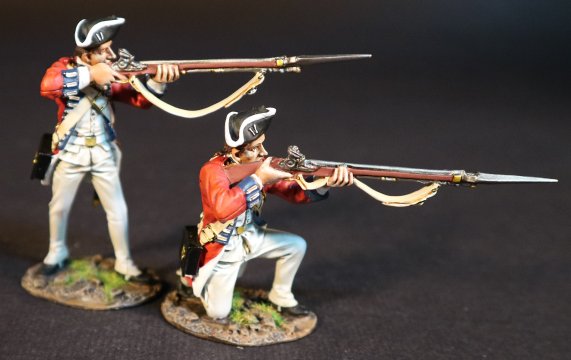
CW7FL-06
THE AMERICAN WAR OF INDEPENDENCE 1775-1783,
THE BATTLE OF COWPENS, JANUARY 17th 1781,
7th REGIMENT OF FOOT (ROYAL FUSILIERS.)
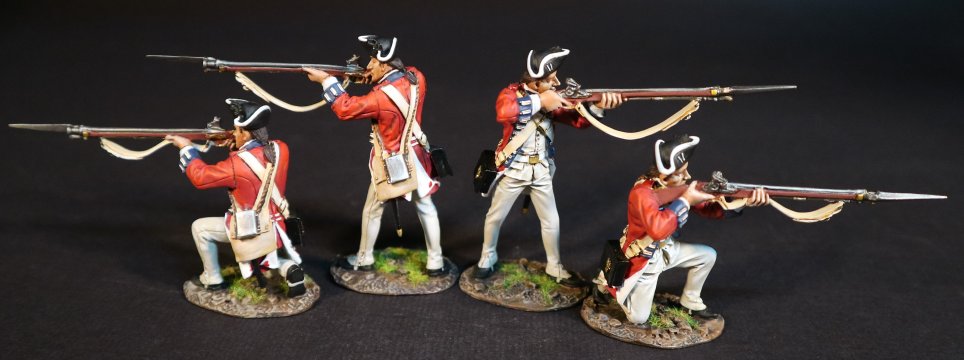
CW7FL-06N
THE AMERICAN WAR OF INDEPENDENCE 1775-1783,
THE BATTLE OF COWPENS, JANUARY 17th 1781,
7th REGIMENT OF FOOT (ROYAL FUSILIERS.)
THE AMERICAN WAR OF INDEPENDENCE
THE BATTLE OF BUNKER HILL, 17th JUNE 1775.
THE ASSAULT ON THE REDOUBT AT BREED’S HILL
Boston was the third largest town in North America, and stood on a Peninsula connected to the mainland by a neck just wide enough to cross at high tide. The harbour, large enough to be strategically significant, and central to the town’s economy, was formed by a chain of islands stretching out to sea, guarded by reefs and ledges.
North west of Boston was Charlestown, a largely rural peninsula one and a half miles long. Charlestown stood at the south east corner with three hills behind it. Bunker’s Hill, nearest the neck of the Peninsula, Breed’s Hill 200 yards above the town and Moulton’s Hill to the north east.

On the 16th June 1775, 3 detachments from Massachusetts regiments under the command of Colonel William Prescott and engineer Captain Richard Gridley, crossed the Charlestown neck and arrived at Bunker Hill.
Captain Richard Gridley and Prescott disagreed as to where they should locate their defense. Some work was performed on Bunker Hill, but Breed’s Hill was closer to Boston and viewed as being more defensible, and they decided to build their primary redoubt there.
Prescott and his men began digging a square fortification about 130 ft a side with ditches and earthen walls. The walls of the redoubt were about 6 feet high.
Work began at midnight, and around 4am one of the British warships spotted the earthworks on Breed’s Hill and opened fire.
The British command agreed that the works posed a significant threat, but were at this time sufficiently incomplete and isolated to offer a chance of a successful attack.
The original British plan was to bypass the redoubt to the north and capture Bunker’s Hill and the neck of the peninsula, thus isolating the redoubt on Breed’s Hill.
The Americans repulsed two British assaults, with significant British casualties. The British captured the redoubt on their third assault, after the defenders had run out of ammunition. The colonists retreated over Bunker Hill, leaving the British finally in control of the Peninsula.
The battle was a tactical victory for the British, but it proved to be a sobering experience for them; they incurred many more casualties than the Americans had sustained, including many officers. The battle had demonstrated that inexperienced militia were able to stand up to regular army troops in battle. Subsequently, the battle discouraged the British from any further frontal attacks against well defended front lines. American casualties were much fewer, although their losses included General Joseph Warren, and Major Andrew McClary, the final casualty of the battle.
BRITISH MARINES
The Marines, which only became “Royal Marines” in 1802, were the Royal Navy’s private army, administered by the Admiralty and controlled by senior naval officers. The rank and file were volunteers and wore army style uniforms and equipment. However they were trained to serve on warships and undertake amphibious operations. The 50 companies, shared between Chatham, Portsmouth and Plymouth, were not regimented, and detachments, or in some cases individual replacements were assigned on an ad hoc basis.
The first Marines sent to Boston were to form a battalion of 600 men under Major Pitcairn, but by March only 336 were present, as they soon became an object of inter service rivalry over pay, food and conditions. Although initially physically inferior to their army comrades, and short of essential equipment for service on land, incessant drilling and regular marches into the countryside soon created a fine unit.
Another group of over 700 men arrived in May, and the whole force formed two battalions, with grenadier and light companies.
The 1st and 2nd Marines were to play an important part in the assault on the southern defences of the Breed’s Hill redoubt.

MBHL-03
THE AMERICAN WAR OF INDEPENDENCE 1775-1783,
THE BATTLE OF BUNKER HILL, JUNE 17th 1775,
THE ASSAULT ON THE REDOUBT AT BREED’S HILL,
BRITISH MARINES,
STANDARD BEARER WITH CHOICE OF TWO FLAGS



MBHL-17
THE AMERICAN WAR OF INDEPENDENCE 1775-1783,
THE BATTLE OF BUNKER HILL, JUNE 17th 1775,
THE ASSAULT ON THE REDOUBT AT BREED’S HILL,
BRITISH MARINES,
2 BRITISH MARINE CASUALTIES

MBHL-17D
THE AMERICAN WAR OF INDEPENDENCE 1775-1783,
THE BATTLE OF BUNKER HILL, JUNE 17th 1775,
THE ASSAULT ON THE REDOUBT AT BREED’S HILL,
BRITISH MARINES,
4 BRITISH MARINE CASUALTIES
THE BATTLE OF COWPENS, JANUARY 17th, 1781.
THE 7th REGIMENT OF FOOT (ROYAL FUSILIERS.)
The Battle of Cowpens was an engagement during the American Revolutionary War fought on January 17th 1781, near the town of Cowpens, South Carolina, between American forces under Brigadier General Daniel Morgan, and British forces under Lieutenant Colonel Banastre Tarleton, as part of the campaign in the Carolinas.
The battle was a turning point in the American reconquest of South Carolina from the British.
Tarleton’s force of 1,000 British troops were set against 2,000 troops under Morgan. Morgan’s forces suffered casualties of only 25 killed and 124 wounded. Tarleton’s force was almost completely eliminated with almost 30% casualties and 55% of his force captured or missing, with Tarleton himself and only about 200 British troops escaping.
Morgan’s forces conducted a double envelopment of the British forces, the only double envelopment of the war.

The Royal Fusiliers (city of London Regiment) was a line infantry regiment of the British Army which has been in continuous existence for 283 years. It was known as the 7th Regiment of Foot until the Childers Reforms in 1881.
In 1747 the regiment was known as the Royal English Fuziliers and was given the precedence of 7th in the Infantry of the Line. On 1st July 1751 it was redesignated as the 7th Regiment of Foot (Royal Fusiliers).
When county titles were added in August 1782 the subtitle (Derbyshire) was added, but this was never used and was later given to a different regiment.
The Royal Fusiliers were sent to Canada in April 1773. The regiment was broken up into detachments that served at Montreal, Quebec, Fort Chambly and Fort St. Johns. In the face of the American invasion of Canada in 1775/76, the 80 man garrison of Fort Chambly attempted to resist a 400 man Rebel force but ultimately had to surrender, losing its regimental colours as a result. The bulk of the regiment was captured when St. John’s fell.
A 70 man detachment under the command of Captain Humphrey Owens assisted with the Battle of Quebec in December 1775.
The men taken prisoner during the defence of Canada were exchanged in British held New York city in December 1776. Here the regiment was rebuilt and garrisoned New York and New Jersey. In October 1777, the 7th participated in the successful assaults on Fort Clinton and Fort Montgomery and the destruction of enemy stores at Continental Village. In late November, 1777 the regiment reinforced the garrison of Philadelphia. During the British evacuation back to New York city, the regiment participated in a diversionary raid in the days leading up to the Battle of Monmouth in June 1778.
In April 1780, the Royal Fusiliers took part in the capture of Charleston. Once Charleston fell, the regiment helped garrison the city. Three companies were sent to Ninety-Six to assist with the training of Loyalist militia companies. An 80 man detachment was also sent to Camden, South Carolina to help build that town’s defences. The detachments were recalled to Charleston for refitting in late August 1780.
The 7th, mounted on horses, along with the two regiments of Loyalist militia, cleared the region north of Georgetown, South Carolina of partisans while en route. The Royal Fusiliers turned the horses over to Lieutenant Colonel Banastre Tarleton’s British Legion upon uniting with Cornwallis in late September and then served as the Army’s rearguard.
Between October 1780 and early 1781, the regiment, having lost about one third of its officers and men to sickness and disease, protected the communication and supply lines between Camden and Winnsboro, South Carolina. On 7th January, 1781, a contingent of 171 men from the Royal Fusiliers was detached from Cornwallis’s Army and fought under the command of Tarleton at the Battle of Cowpens in January 1781.
The Royal Fusiliers were on the left of the line of battle: Tarleton was defeated and the regiment’s colours were once again captured, and stored in the baggage wagons.
A 19 man detachment from the regiment fought through North Carolina participating in the Battle of Guilford Court House in March 1781 and ultimately the siege of Yorktown, where it served with the regiment’s Light Infantry Company. There was another detachment, composed largely of men recovered from the hospitals and recruits, which remained in the South under the command of Lt. Col. Alured Clarke. These men remained in garrison in Charleston, until they were transferred to Savannah, Georgia in December 1781.
The regiment returned to England in 1783.

CW7FL-06
THE AMERICAN WAR OF INDEPENDENCE 1775-1783,
THE BATTLE OF COWPENS, JANUARY 17th 1781,
7th REGIMENT OF FOOT (ROYAL FUSILIERS.)

CW7FL-06N
THE AMERICAN WAR OF INDEPENDENCE 1775-1783,
THE BATTLE OF COWPENS, JANUARY 17th 1781,
7th REGIMENT OF FOOT (ROYAL FUSILIERS.)


